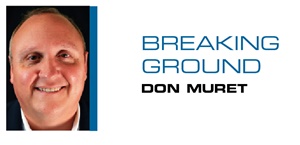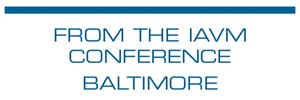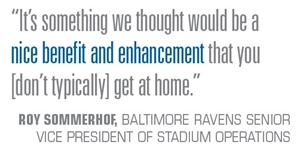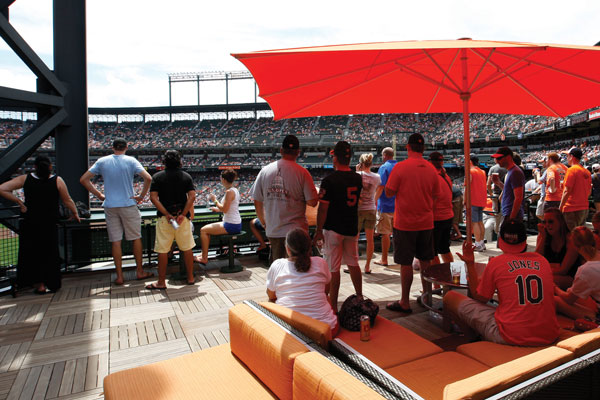 |
As a gathering spot for any ticket holder, the center-field rooftop deck is a popular hangout. Fifty-one ticketed seats sit below the drink rail stools.
Photo by: COURTESY OF THE BALTIMORE ORIOLES
|
Oriole Park at Camden Yards, MLB’s first retro-themed ballpark, has influenced the development of multiple stadiums and arenas over the past two decades.
Twenty-three years after Camden Yards opened in 1992, the ballpark remains in pristine condition thanks to the stewardship of
the Angelos family, who own the Baltimore Orioles, and the
Maryland Stadium Authority, their landlord.
Delaware North Sportservice has done its part as well, investing $11 million in concession upgrades after taking over the park’s food service in 2011. One year later, the vendor opened the center-field roof deck bar and Dempsey’s, a full-time restaurant situated in the old B&O Warehouse along Eutaw Street. It’s named for Rick Dempsey, the former Orioles catcher who now works for Mid-Atlantic Sports Network, the team’s regional broadcaster.
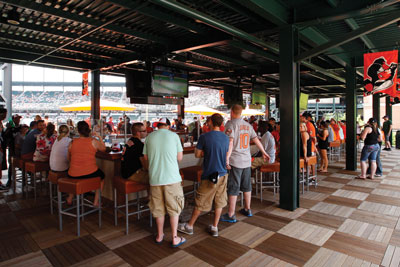 |
The center-field bar may not have great views of action on the field, but it’s a destination amenity that resonates with fans.
Photo by: COURTESY OF THE BALTIMORE ORIOLES
|
As the stadium ages gracefully, the Orioles and
Populous, the ballpark’s original architect, are in the early stages of planning additional improvements, said
John Angelos, the team’s executive vice president and chief operating officer.
Future renovations could include constructing party decks in the left- and right-field corners of the upper deck, similar to the 2012 center-field retrofit; a home plate club; an expansion of the group picnic area down the left-field line;
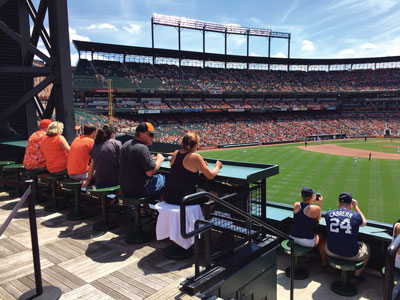 |
“To my way of thinking, the [center-field deck] is an amenity for everybody,” says John Angelos, Orioles EVP and COO.
Photo by: DON MURET / STAFF
|
and updated video boards.
In addition, the Orioles and Populous are considering the possibility of creating an open concourse on the first level by tearing out sections of seats, and the concession stands and restrooms behind them, to create a large walk-through area with views to the field, Angelos said.
To this point, no specific projects or costs have been identified. Before moving ahead, the team plans to conduct fan surveys to determine what they would like to see improved, keeping in mind the delicate balance for maintaining the park’s old-timey feel, Angelos said.
The idea of installing party decks in the upper-deck corners is a good place to start. The center-field rooftop deck has been a big hit for fans holding tickets to the 51 fixed seats and others hanging out behind them at the bar and the high-top tables and couches whose awnings protect them from the sun.
The roof deck seats are priced at $35 to $50 a person per game. The remaining space is free for all ticket holders regardless of seat location.
For the Orioles, the upper-deck corners are the toughest seats to sell consistently with the exception of Student Night, Family Night and the Junior Orioles Dugout Club. For those designated games, up to 12,000 fans buy tickets.
At Camden Yards, on a 90-degree Sunday afternoon in early August, the bar was jammed for a game against the Tigers despite crowds standing in front of the bar patrons blocking views to the game.
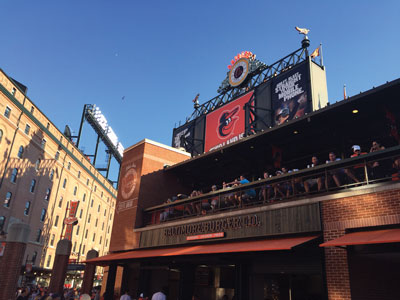 |
The center-field rooftop deck opened three years ago.
Photo by: DON MURET / STAFF
|
Several televisions mounted above the bar help fans stay connected to the game. A few fans watched those screens. Many others, though, were engaged in conversations among friends and tapping their mobile devices while they downed frozen margaritas, oblivious to the action on the field.
When the center-field rooftop deck opened three years ago, it was all general admission, but during the 2013 season the Orioles switched to paid tickets for the seats facing the field after receiving many requests from fans to reserve those seats for the entire game. Officials recognized they held value, similar to Fenway Park’s Green Monster seats, Angelos said.
“It’s also easier to manage if you sell them and leave the back of the deck for standing room, where it’s roped off,” he said. “It’s popular. You can come and go, whether you buy a $10 ticket or an $80 ticket. It’s a good test for the future, [indicative] of the things people like.”
The Colorado Rockies completed a similar retrofit last year with the Rooftop at Coors Field, a Populous project. Angelos mentioned the general admission space in the upper deck in right field as one blueprint for Camden Yards’ future. Angelos visited the Rooftop after Populous architects showed him the design before it was built.
He’s also paying close attention to the $350 million, multiyear renovation of Wrigley Field. Angelos sees a parallel between the Cubs’ 101-year-old ballpark and Camden Yards. Both stadiums are iconic in their own way, he said, and some Wrigley upgrades could be adopted in Baltimore.
“For us,” Angelos said, “the question on the table is, ‘Do you spend money in the upper deck, where for many games, you have fewer people? Or do you spend it on the waterfront property, the lower deck, which is more prime because it has more foot traffic.’
“You’d like to create a destination for fans on every level, like the center-field bar, that’s social and where you don’t have to pay $500 for a ticket. To my way of thinking, the [center-field deck] is an amenity for everybody.”
> RAVENS NEST: Down the street from Camden Yards, the Baltimore Ravens and Populous are working on a 12-year master plan for M&T Bank Stadium.
The two end-zone video boards top the list for upgrades, said Roy Sommerhof, the team’s senior vice president of stadium operations.
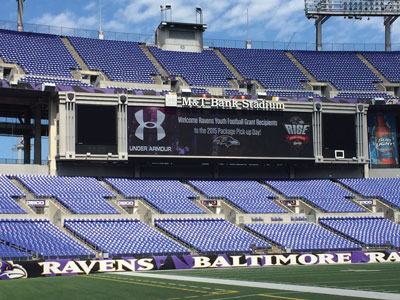 |
Expanding the Ravens’ end-zone video boards could disrupt seating and sight lines.
Photo by: DON MURET / STAFF
|
When the stadium opened in 1998, the screens were the NFL’s largest. Seventeen years later, they’re “not nearly at that level,” Sommerhof said, and the Ravens would like to expand the midlevel boards vertically by building a new framework to hold larger screens.
Going bigger would risk the loss of some seats blocked by the larger boards. Scoreboard maker Daktronics has joined the discussions to help the Ravens make the adjustments and resolve those issues, he said.
For this season, the Ravens are the newest team to introduce FreeD at their facility, new technology that captures reverse angles on replays shown on stadium video boards. To accommodate the system, produced by Replay Technologies, the Ravens converted two storage closets to handle the equipment and production aspects. The system revolves around 21 robotic cameras in the seating bowl that capture and send data to those rooms for processing and editing before the images are displayed on the big screens.
It takes about 30 seconds, a relatively long period of time for replay, to process FreeD. As a result, the Ravens will restrict use of the technology for major plays such as touchdown passes and interceptions, Sommerhof said. The system is to make its debut Thursday for the Ravens’ first preseason game.
The Ravens first saw the technology in place at
AT&T Stadium last year during a preseason game against the Dallas Cowboys.
“It’s something we thought would be a nice benefit and enhancement that you [don’t typically] get at home,” Sommerhof said.
Elsewhere on the tech front, the team invested $6.5 million to install stadiumwide Wi-Fi with service provider Extreme Networks and PCM, the system integrator. The Wi-Fi will help ease congestion and traffic on the stadium’s distributed antenna system, which fans already use for cell service.
To mark the Ravens’ 20th season, the team hired Disney Institute to educate 1,500 people in proper customer service, both game-day workers and the team’s full-time managers and supervisors. It’s a two-year program. Disney did the same thing for the team’s first year of operation, Sommerhof said.
> OVERHEARD: The San Diego Chargers have interviewed Legends and Jack Hill, among others, for the job of owner’s representative for their joint stadium project with the Oakland Raiders in Carson, Calif. More firms were scheduled to be interviewed last week, and the team hopes to make a selection by the end of August, confirmed Mark Fabiani, the Chargers’ special counsel. Hill served as owner’s rep for both Levi’s Stadium and AT&T Stadium. … Syracuse University has selected Populous to design a major renovation of the Carrier Dome that includes building a fixed steel roof for the multisport facility. The project could reach $400 million and extend to redevelopment of three recreational sports venues just east of the dome. Thornton-Tomasetti is the structural engineer. In February, the ACC school hired Populous to study roof options for the dome. … Generator Studio is designing improvements to Scottrade Center, including locker room upgrades to bring the NHL arena into compliance for hosting NCAA basketball tournament games. Brailsford & Dunlavey is project consultant. … In the Twin Cities, Generator Studio is planning a cheerleader suite and pregame space for mascot Victor the Viking at the Minnesota Vikings’ new $1 billion stadium, said Tom Proebstle, the firm’s founder and design director. … CSL International hired Gary Birdsall, a former vice president with Turner Construction’s sports group.
> NEW IN OMAHA: CenturyLink Center Omaha will invest $1 million to renovate the arena’s 32 suites. They’re sold out with a waiting list at the arena, the home of Creighton University men’s basketball, said Roger Dixon, the venue’s president and CEO. … Former SMG and Global Spectrum executive Neil Sulkes is consulting on the development of 8,500-seat Bert Ogden Arena in Edinburg, Texas. The $68 million home of the D-League’s Rio Grande Valley Vipers opens in October 2016. … Frank Russo, senior vice president at Spectra Venue Management, says he’s pursuing more business in China, following the lead of parent company NBCUniversal’s theme park expansion in Asia. First stop is Beijing, where Universal Studios is set to open a $3.3 billion development in 2019. … VenuWorks’ five-year deal to take over Iowa State Center, a collection of three university-owned theaters in Ames, includes selling naming rights for the complex to help pay for building a hotel near Hilton Coliseum. The plan, pending local approvals, is to sell those rights for $20 million over 25 years, said Steve Peters, VenuWorks’ president. The hotel would include a 200-seat premium club space for pregame and postgame functions tied to Iowa State men’s basketball games. VenuWorks’ development partners are Sink Combs Dethlefs, Mortenson and hotel operator Kinseth Hospitality. Tammy Koolbeck takes over as Iowa State Center’s executive director after working for VenuWorks’ corporate office and U.S. Cellular Center in Cedar Rapids, Iowa. … The Grateful Dead ain’t dead yet. After its five “Fare Thee Well” shows grossed $52 million in ticket sales this summer, three surviving members join guitarist/vocalist John Mayer for a fall tour of about 20 arenas, according to Live Nation officials, including a Halloween show at Madison Square Garden.
Don Muret can be reached at dmuret@sportsbusinessjournal.com. Follow him on Twitter @breakground.



